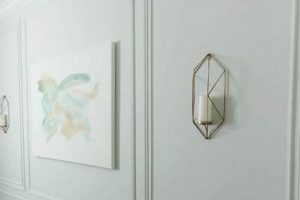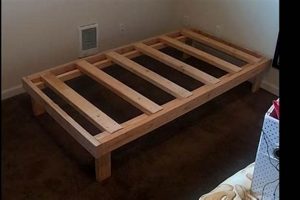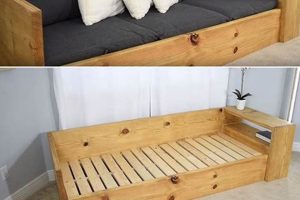Construction of sleeping platforms tailored for queen-sized mattresses through individual effort represents a cost-effective and customizable solution for bedroom furniture. These projects, often undertaken by individuals with varying levels of woodworking experience, result in a bed frame specifically designed to accommodate a standard queen mattress, typically measuring 60 inches wide by 80 inches long. A completed project can range from simple platform designs to more elaborate constructions incorporating headboards, footboards, or storage compartments.
The appeal of self-constructed sleeping platforms stems from multiple factors. Economic savings can be realized by sourcing materials directly and avoiding retail markups. Customization allows for the creation of a frame that perfectly matches individual aesthetic preferences and room dimensions. Furthermore, the process provides a sense of accomplishment and fosters practical skills. Historically, self-sufficiency in furniture construction has been a common practice, reflecting both resourcefulness and a desire for personalized home furnishings. The resurgence of this practice aligns with contemporary trends emphasizing sustainability and individuality.
This discussion will now examine diverse construction methodologies, material selection criteria, design considerations for both aesthetics and functionality, and essential safety precautions related to the process. Subsequent sections will explore specific design plans suitable for a range of skill levels, addressing potential challenges and offering practical solutions for a successful outcome.
Essential Construction Considerations
The following points offer guidance to ensure a structurally sound and aesthetically pleasing result when building sleeping platforms designed for queen-sized mattresses. Careful attention to these details can mitigate potential issues and maximize the lifespan of the finished product.
Tip 1: Material Selection: Prioritize kiln-dried hardwoods or construction-grade lumber. Kiln-drying minimizes warping and shrinkage, ensuring dimensional stability over time. Consider the weight-bearing capacity of the chosen wood species in relation to mattress and occupant weight. Softwoods may require additional bracing.
Tip 2: Precise Measurements: Accuracy is paramount. Verify mattress dimensions prior to cutting any materials. Account for a slight clearance (approximately 1/4 inch on each side) to facilitate easy placement and removal of the mattress. Inaccurate measurements can lead to instability or an ill-fitting frame.
Tip 3: Robust Joinery: Employ secure joinery techniques, such as mortise and tenon, dowel joints, or pocket-hole screws. Glue all joints with a high-quality wood adhesive. Reinforce joints with metal fasteners where necessary. Weak joints are a primary cause of structural failure.
Tip 4: Adequate Support: Ensure sufficient center support to prevent sagging. For platform designs, consider adding additional slats or a solid support panel beneath the mattress. Insufficient support can lead to mattress damage and discomfort.
Tip 5: Smooth Surfaces: Sand all surfaces thoroughly, paying particular attention to edges and corners. Apply a non-toxic sealant or finish to protect the wood and prevent splinters. A smooth surface improves comfort and reduces the risk of injury.
Tip 6: Hardware Selection: Use high-quality screws, bolts, and other hardware that are appropriate for the chosen materials. Avoid using undersized or weakened fasteners. Regularly inspect hardware for signs of wear and tighten or replace as needed.
Tip 7: Consider Aesthetics: Before beginning construction, develop a detailed design plan that incorporates desired aesthetic elements, such as a headboard, footboard, or storage compartments. Ensure that the design is structurally sound and complements the overall style of the room.
Adherence to these guidelines contributes significantly to the creation of a durable, functional, and visually appealing sleeping platform. Proper planning and execution are essential for a successful construction project.
The following sections will provide specific design examples and address potential challenges encountered during the construction process. Careful consideration of the previous points will greatly enhance the success of those projects.
1. Frame Dimensions
Frame dimensions are a foundational element in the successful construction of sleeping platforms for queen-sized mattresses. The accurate determination and precise execution of these dimensions directly impact the functionality and overall usability of the finished project. Deviations from standard queen mattress specifications (typically 60 inches wide by 80 inches long) can lead to instability, mattress slippage, or difficulties in bed-making. For example, a frame that is even slightly undersized will make it challenging to place and remove the mattress, while an oversized frame may result in unsightly gaps and increased wear and tear on the mattress edges. Therefore, accurate frame dimensions are a prerequisite for a well-functioning and visually appealing sleeping platform.
Furthermore, the internal dimensions of the frame dictate the type and placement of support structures. Insufficient support, arising from dimensional miscalculations, can lead to mattress sagging and premature failure. Consider a scenario where the internal span between side rails exceeds the recommended distance for the chosen slat material. This will inevitably result in inadequate support and a compromised sleeping surface. Conversely, overly robust support structures may restrict airflow and potentially contribute to moisture buildup, impacting mattress hygiene. Therefore, careful consideration of internal frame dimensions is crucial for optimizing mattress support and longevity.
In conclusion, the interplay between frame dimensions and mattress compatibility is essential in sleeping platform construction. Accurate measurement and execution are non-negotiable for achieving a functional and aesthetically pleasing outcome. Potential challenges related to dimensional accuracy can be mitigated by verifying mattress specifications, employing precise measuring tools, and conducting thorough test fittings during the construction process. Recognizing the critical influence of frame dimensions contributes to the overall success and durability of the resulting furniture piece.
2. Material Durability
Material durability constitutes a critical factor in the construction of sleeping platforms designed for queen-sized mattresses. The long-term structural integrity, safety, and overall lifespan of the finished frame are directly contingent upon the inherent properties and resistance to degradation of the chosen materials. Selection criteria must extend beyond initial cost considerations to encompass factors such as load-bearing capacity, resistance to moisture and insect infestation, and susceptibility to warping or cracking.
- Wood Species Selection
The choice of wood species significantly impacts the durability of the frame. Hardwoods, such as oak, maple, or birch, offer superior strength and resistance to wear compared to softwoods like pine or fir. For example, a frame constructed from pine may exhibit greater susceptibility to dents, scratches, and structural weakening over time, particularly under heavy use. The selection of an appropriate wood species, therefore, necessitates a thorough understanding of its mechanical properties and suitability for the intended application.
- Fastener Strength and Corrosion Resistance
The type and quality of fasteners employed in the construction process directly affect the frame’s long-term stability. Substandard screws, nails, or bolts can loosen, shear, or corrode, leading to joint instability and potential structural failure. Employing galvanized or stainless steel fasteners in areas prone to moisture exposure mitigates the risk of corrosion and ensures lasting joint integrity. A frame assembled with low-quality fasteners may exhibit premature weakening and require frequent repairs.
- Finish Application and Protection
The application of a protective finish serves not only to enhance the aesthetic appeal of the frame but also to safeguard it from environmental factors that can compromise its durability. Sealants, paints, and varnishes provide a barrier against moisture, UV radiation, and physical abrasion. Failure to apply an adequate finish can result in warping, cracking, discoloration, and accelerated deterioration of the wood. A properly finished frame will exhibit greater resistance to damage and maintain its structural integrity over an extended period.
- Moisture Resistance and Treatment
Wood is inherently susceptible to moisture-related damage, including rot, decay, and dimensional instability. In environments with high humidity or potential water exposure, the use of pressure-treated lumber or the application of water-resistant coatings becomes essential. Untreated wood can quickly deteriorate in damp conditions, compromising the structural integrity of the frame and potentially leading to mold growth. Proactive measures to mitigate moisture exposure are crucial for ensuring the longevity of the structure.
The interconnectedness of these facets underscores the importance of a holistic approach to material selection and construction techniques. Each component plays a vital role in determining the overall durability and lifespan of the sleeping platform. Neglecting any single aspect can compromise the integrity of the entire structure. Careful consideration of these factors represents a sound investment in the longevity and safety of a self-built queen bed frame.
3. Joint Strength
Joint strength is a critical determinant of the structural integrity and longevity of sleeping platforms designed for queen-sized mattresses. The ability of a constructed joint to withstand applied forces and resist deformation or failure directly influences the stability and safety of the overall frame. Selection of appropriate joinery techniques and meticulous execution are paramount for a durable and reliable outcome.
- Type of Joint and Load Distribution
Different joint types exhibit varying capacities for load distribution and resistance to specific forces. Mortise and tenon joints, for instance, provide exceptional resistance to shear and racking forces, making them well-suited for load-bearing connections in the frame. Dowel joints, while simpler to construct, may offer less resistance to these forces and are better suited for lighter-duty applications. The choice of joint should align with the anticipated loads and stresses the frame will experience under normal use. Incorrect joint selection can lead to premature failure and instability.
- Adhesive Selection and Application
Adhesive plays a critical role in augmenting the strength and rigidity of wood joints. The selection of an appropriate adhesive, such as a high-quality wood glue, and its proper application are crucial for achieving optimal bond strength. Insufficient adhesive or improper application techniques, such as gluing dirty surfaces or applying inadequate pressure, can compromise the integrity of the joint. A weak adhesive bond can lead to joint separation and structural weakening over time.
- Fastener Usage and Compatibility
The use of fasteners, such as screws or bolts, can further enhance the strength and security of wood joints. However, the type and size of fasteners must be carefully selected to ensure compatibility with the wood species and joint type. Overdriving screws can strip the threads and weaken the joint, while undersized fasteners may not provide adequate holding power. The appropriate placement and tightening of fasteners are also critical for achieving optimal joint strength. Misapplication can damage the wood, creating a weak point and eventually leading to failure.
- Precision of Cut and Fit
Precise cutting and fitting of joint components are essential for maximizing surface area contact and achieving optimal bond strength. Gaps or irregularities in the joint surfaces reduce the effective gluing area and compromise the overall integrity of the connection. Accurate measurements, precise cutting tools, and meticulous assembly techniques are necessary for ensuring a tight, gap-free fit. Poor fitting joints may shift, bend, or wobble with use, degrading their effectiveness.
These facets of joint strength are inextricably linked in the context of sleeping platforms designed for queen-sized mattresses. The selection of robust joint types, the proper application of adhesive and fasteners, and the adherence to precise cutting and fitting techniques all contribute to the overall structural integrity and longevity of the frame. Prioritizing joint strength in the construction process is essential for ensuring a safe, stable, and durable sleeping platform that can withstand the rigors of daily use.
4. Support Structure
The support structure in self-constructed queen-sized mattress platforms directly dictates the frame’s capacity to bear weight, maintain its shape, and provide a level sleeping surface over extended periods. The effectiveness of this support system directly influences the mattress’s lifespan and the quality of sleep experienced. Insufficient or poorly designed support leads to mattress sagging, uneven weight distribution, and potential frame failure. For example, a platform constructed with widely spaced slats or lacking a central support beam will inevitably exhibit greater deflection under load than a frame with closely spaced slats and robust central reinforcement. The cause-and-effect relationship is clear: inadequate support directly results in compromised structural integrity and reduced user comfort.
Several practical support structure designs are commonly employed. Solid platform bases offer uniform support but can restrict airflow. Slat systems, conversely, promote ventilation but require careful attention to slat spacing and material strength. Central support beams, often integrated into frames exceeding a certain width, prevent bowing and ensure even weight distribution across the entire platform. The choice of support system should consider factors such as mattress type (memory foam, innerspring, hybrid), occupant weight, and desired level of firmness. For instance, a heavy memory foam mattress may benefit from a solid platform, while a lighter innerspring mattress may perform adequately with a well-designed slat system. Real-world examples demonstrate that frames incorporating both closely spaced slats and a central support system provide the most reliable and durable support for a wide range of mattress types and body weights.
In summary, the support structure represents a fundamental component of any successful self-built queen-sized mattress platform. Its design and execution directly impact the frame’s longevity, stability, and the user’s sleeping experience. Challenges related to support structure design can be mitigated through careful material selection, precise construction techniques, and a thorough understanding of weight distribution principles. The long-term performance of a self-built bed frame hinges on prioritizing the implementation of a robust and well-engineered support system.
5. Design Aesthetics
Design aesthetics significantly influence the perceived value and satisfaction derived from self-constructed queen-sized sleeping platforms. While structural integrity and functional performance remain primary considerations, the visual appeal of the frame directly impacts its integration into the bedroom environment and its contribution to overall interior design harmony. A frame exhibiting sound construction but lacking aesthetic consideration may detract from the intended ambiance of the room. Conversely, a visually appealing frame that compromises structural stability represents a failure in holistic design. The cause-and-effect relationship is evident: thoughtful aesthetic design enhances the user experience, while its absence diminishes it. Examples include frames with integrated headboards mirroring architectural details within the room, or platforms finished with stains that complement existing furniture, creating a cohesive and visually pleasing space.
Practical application of design aesthetics involves careful consideration of multiple factors. Material selection plays a crucial role, with the choice of wood species, stain color, and hardware influencing the frame’s overall appearance. For example, using reclaimed wood imparts a rustic aesthetic, while selecting sleek metal hardware contributes to a modern style. Joinery techniques also contribute to visual appeal; exposed joinery, such as dovetail joints, can serve as a decorative element. The incorporation of features such as integrated lighting, storage compartments, or upholstered headboards further enhances both functionality and visual appeal. Successful implementation requires a balance between aesthetic preferences and practical construction considerations. A complex design, while visually appealing, may present significant challenges for individuals with limited woodworking experience.
In conclusion, design aesthetics constitute an integral component of successful self-constructed queen-sized sleeping platforms. While structural integrity and functionality are paramount, the visual appeal of the frame directly influences its integration into the bedroom environment and the user’s overall satisfaction. Potential challenges related to aesthetic design can be mitigated through careful planning, material selection, and a realistic assessment of construction capabilities. Prioritizing both functional and aesthetic considerations ensures the creation of a sleeping platform that is both structurally sound and visually harmonious, contributing to a more comfortable and aesthetically pleasing living space.
Frequently Asked Questions
This section addresses common inquiries regarding the design, construction, and maintenance of sleeping platforms specifically tailored for queen-sized mattresses.
Question 1: What are the primary advantages of building a sleeping platform as opposed to purchasing a commercially manufactured bed frame?
Construction of a sleeping platform offers customization options unavailable in mass-produced frames, often at a reduced cost. Individuals can tailor the dimensions, materials, and aesthetic elements to precisely match their needs and preferences. Additionally, the process provides opportunities for skill development and resourcefulness.
Question 2: What are the most critical factors to consider when selecting materials for a queen bed frame?
Load-bearing capacity, resistance to moisture and insect infestation, dimensional stability, and aesthetic appeal are paramount considerations. Kiln-dried hardwoods generally offer superior strength and durability compared to softwoods. Fasteners must be corrosion-resistant and appropriately sized for the chosen materials. Finishes should provide protection against moisture and abrasion.
Question 3: What joinery techniques are best suited for ensuring a structurally sound and durable queen bed frame?
Mortise and tenon joints, dovetail joints, and properly executed screw or bolt connections offer robust resistance to racking forces and weight-bearing stresses. Adequate gluing and reinforcement of joints are essential for long-term stability. The selection of joint type should align with the skill level of the constructor and the anticipated loads.
Question 4: What is the recommended approach for providing adequate mattress support in a platform design?
Solid platform bases offer uniform support but may restrict airflow. Slat systems, with appropriately spaced slats, promote ventilation. Central support beams are critical for preventing sagging in frames exceeding a certain width. The choice of support system should be tailored to the mattress type and occupant weight.
Question 5: What safety precautions should be observed during the construction process?
Eye protection, respiratory protection, and hearing protection are essential when operating power tools. Ensure a well-ventilated workspace to minimize exposure to dust and fumes. Securely clamp workpieces to prevent movement during cutting and assembly. Exercise caution when lifting heavy materials. Consult safety guidelines for all power tools and adhesives used.
Question 6: How can the lifespan of a self-constructed queen bed frame be maximized?
Regularly inspect joints for looseness and tighten or replace fasteners as needed. Apply a protective finish to prevent moisture damage and insect infestation. Avoid overloading the frame beyond its designed weight capacity. Address any signs of structural weakness promptly to prevent further deterioration.
In summary, meticulous planning, appropriate material selection, robust construction techniques, and diligent maintenance practices are fundamental to creating a durable, safe, and aesthetically pleasing self-constructed queen bed frame.
The subsequent section will offer detailed construction plans for various skill levels, accompanied by step-by-step instructions and troubleshooting advice.
Conclusion
The preceding analysis has explored essential elements of constructing sleeping platforms tailored for queen-sized mattresses. Material durability, joint strength, support structure, and design aesthetics all contribute significantly to the functionality and longevity of self-built bed frames. Addressing these factors systematically ensures a stable and visually pleasing outcome.
Successful implementation of “diy queen bed frames” requires careful planning, meticulous execution, and a commitment to safety protocols. The information presented serves as a foundation for informed decision-making and promotes the creation of furniture that reflects individual needs and craftsmanship. Continued attention to detail and adherence to best practices are crucial for maximizing the value and durability of these projects.







